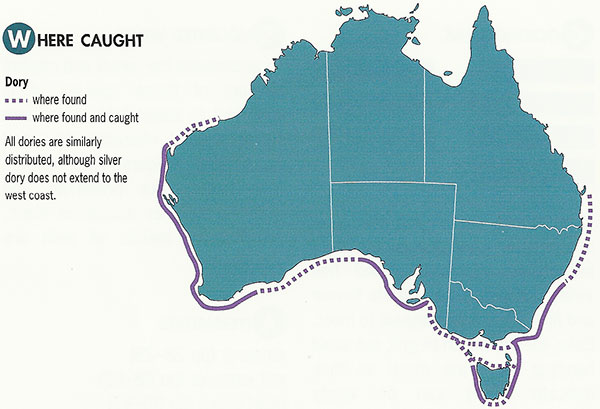Dories are fine table fishes, readily available freshly chilled and frozen all year round.
They have succulent, white, sweet and finely textured flesh that can be baked, grilled, barbecued, fried, steamed or poached.
Dory fillets are delicate and often best coated or wrapped in foil for cooking.
Catch limits
| Catch limit | Fishing Mortality* | Biomass** |
|---|---|---|
Catch Limit 334 tonnes For the 2025–26 Season | G;Not subject to overfishing | G;Not overfished |
* Fishing mortality status relates to the level of fishing pressure on a stock - specifically, whether fishing mortality in the year being assessed is likely to result in the stock becoming overfished or prevent the stock from rebuilding from an overfished state. If fishing mortality exceeds either of these thresholds, a stock is considered to be subject to overfishing.
** Biomass status relates to how many fish there are - specifically, whether the biomass in the year being assessed is above the level at which the risk to the stock is considered to be unacceptable. The HSP defines this level as the limit reference point, below which the stock is considered to be overfished.
Scientific name: Zenopsis nebulosa
Family: Zeidae
Other names: Deepsea dory, mirror perch, trawl dory, silver dory
Description: Mirror dory have highly compressed plate-like bodies with large heads and large telescopic mouths. The body is silver-grey with a large faint greyish blotch on the sides. They are mostly scaleless. The fins are spiny.
Size (length and weight): Up to 70 cm in length and 3 kg. Commonly found at 40‑50 cm in length and 0.7‑1.2 kg.
Life span: Up to 12 years.
Habitat: Mirror dory are a demersal species that lives close to the sea bed in coastal and continental shelf waters. They can be found at depths of 50‑600 metres. Mirror dory are thought to be generally solitary. Sometimes found in association with gemfish.
Prey: Fish such as jack mackerel, crustaceans and molluscs.
Predators: Sharks, large bony fish and potentially marine mammals such as dolphins.
Reproduction: Mirror dory reach reproductive maturity at about 5 years of age. Spawning occurs over an extended period in winter. Mirror dory aggregate for spawning in waters along the New South Wales upper slope. Fecundity is thought to be low, with the possibility of serial spawning.
| Fishery found in | Gear used | Catch of this species is targeted or incidental |
|---|---|---|
| Southern and Eastern Scalefish and Shark Fishery | Bottom trawl | Incidental |
Mirror dory are predominantly caught incidentally. The Commonwealth catch of mirror dory is managed by quota. This means the catch of this fish by commercial fishers is restricted by weight. AFMA also restricts the number of boats and the type and amount of gear that can be used to fish for mirror dory.
Commercial fishermen are required to fill in records of their catches, during each fishing trip and when they land their catch in a port. This helps us keep records of how much is being caught.
AFMA decide on the amount that can be caught each year from expert advice and recommendations from fisheries managers, industry members, scientist and researchers.
For more information about mirror dory stock assessment, refer t the Tier 4 stock assessments 2018.
In Commonwealth waters, mirror dory are predominantly caught in waters off the southern half of Australia at a depth of 350-550 metres on the continental shelf and slope close to the sea bed.

Fishers use trawl nets to catch mirror dory.
Sometimes, bottom trawling can catch unwanted species of fish (not the type of fish the net was supposed to catch). This is known as bycatch and it is monitored by on-board fishery observers who assess the environmental impact of the trawling.
Although it is not physically possible to trawl on reef structures, significant long-term damage can occur if sensitive habitat areas like corals, sponges and seagrass beds are trawled. To ensure these sensitive habitat areas are protected from trawling, management arrangements such as area closures are extensively used.
To reduce the impacts of fishing on the environment, AFMA have a number of management arrangements and strategies in place including:
- minimum mesh sizes for otter trawls to reduce the catch of small and juvenile fish
- mitigation devices to reduce interactions with threatened endangered and protected species
- closing some areas to fishing to protect vulnerable species and habitats.
Gear
Want to know more?
This is just an overview of mirror dory, if you want to know more see the links below.
This fish is managed under the Southern and Eastern Scalefish and Shark Fishery.